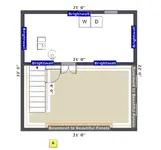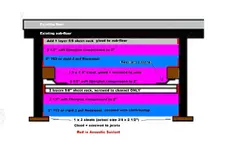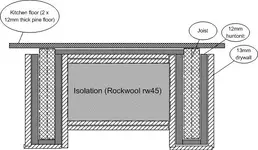F
Furious G
New member
Hello all,
With the help of a contractor, I'm finishing a basement area (12 x 24 x 7) in our new house.

The studio area I'll be talking about is solely the tan rectangle area with the stairs. Addditionally, the long wall not impeded by the stairs measures 24 inches, not 21.
This is my first thread here, so forgive me if I make some newbie mistakes. I will try to be as forthcoming and detailed as possible about what I want to achieve with the ceiling and where I'm at so far. I'm going to address everything regarding the ceiling - the floor above/below, as well as the lighting/wiring. I have to pre-know a lot of this if as will save me time/money later because I'm working with a contractor who will 'just do it the standard way' unless I say otherwise.
Music is my living (performer/gigging, teaching, recording, producing) and this basement is going to be lesson studio by day, recording environment by night, as well as a backdrop to my YouTube channel for online lessons and videos. The video content will be everything from blogs to instructional to performance based. Succinctly, this is not a hobby, and I'm a 'once and done, do-it-right kinda guy. Important to mention here - I'm not a huge DIY guy (another reason for using a contractor).
The area above where i'm going to be placing the mixing desk (wall opposite the stairs) is the living room of the house. I have a 6 and 4 year old with heavy feet, and obviously very distracting when I'm teaching, even more so when recording. I want to be able to sing / belt some takes at 2:00 AM after a gig without worrying if it's going to wake the wife and kids up on the second floor. I know I cannot get TOTAL isolation given the limitations that I've presented myself (mentioned in detail below), but want to do what I can:
The solution for the ceiling I come up with has to be a very balanced four-sided square in no particular order:
1. Sound isolation
2. Sound absorption
3. Aesthetically pleasing
4. Financially sound
With #4, it doesn't mean cheap, but if name brand product 'A' in the acoustic treatment area is two times more expensive as product 'B' that you can get in bulk at a discount store or more common, and has a negligible difference in the said acoustic goals - that's the kind of stuff I'm trying to find out ahead of time. The basement finishing job itself is taking me to the cleaners but I'm getting what I pay for. They guarantee for 50 years, and the materials they use for the walls and floor (besides the wooden door to the laundry room) are moisture proof, mold-proof, and inorganic.
The company is going to be doing the job about a week from now, and I'd like to be able to get the ceiling piece done in its' entirety pretty quickly shortly after they are done so I can really start working and be done with the construction part, just having to worry about bass trapping, diffusion and absorbing reflections with treatment on the walls as I go. I work between 70-100 hours a week between gigging, teaching, recording, etc so time and simplicity are of great value in my scenario as well.
Regarding materials, if possible (which may not be), I want to use a substitute for drywall in the mass/isolation department. As expressed, I don't want to cover the joists or lower the ceiling anymore, and want access to wiring and ductwork as well w/o having to cut through drywall to replace / repair, so the traditional drywall ceiling with resilient channel is not the route I'd like to go. Ceilings are just shy of 7 inches and don't want to lose anymore height.
Also regarding drywall, as mentioned earlier, I'm trying to keep everything in the basement inorganic and moisture proof. I know there's probably no way around this from the insulation angle, as Rockwool, or fluffy are compromised when they get wet. Mass loaded vinyl, PVC molding etc come to mind.
Have you guys had any experience with or have any opinions about this stuff for the ceilings?:
https://www.youtube.com/watch?v=wv4IMnySxyc
There were two solutions with the same goals in mind I've come across in the various forums which seemed very similar to my situation. Both had great drawings of their ideas, both offer isolation, High, mid, and low-frequency absorption, and I'm a very visual guy, so diagrams are everything to me:
Solution A: Ran across this in Sayer's thread from a poster named knightly and it seemed to follow Grevais' (Mass-Air-Mass with additional A after the last M).

This seems to be the be-all end all that I've found if you want to leave the joists exposed for absorption and isolation. Three concerns / adjustments I would have in my specific scenario:
1. Money and time factor it would take to do this on my end (I need to get working soon after the finishing is done and will have a bit more budget, but not a ton).
2. I only have 7 inch joists (cavity is 14inches across BTW), so this would have to be modified
3. All this treatment seems like it would greatly help, but it seems to me that the largest issue, the joists, will still be booming in my case. They are directly connected (coupled) to the subfloor and the transmission of the impact immediate. Awesome for isolation of sound going up, not so much sound coming down.
Solution B: This seemed to address the joists and use M-A-M from a poster named eirikur here from the gearslutz forum:

I want to add that the frustrating thing about all of the threads that I've come across regarding this topic - there seems to be a ton of sound, solid planning and then very little report on results and/or adjustments needed after the fact after work is done (how does it SOUND, recording results, band rehearsal, to what degree it kept noise in the work environment and kept noise out from other areas etc).
Soo…all of the above being said with the intended usage of the space and four finishing goals in mind, do you guys have any thoughts and / or creative solutions on materials or specific approaches you could recommend? Diagrams would be very welcomed and appreciated.
Regarding addressing the impact problem from above:
The floors are hardwood right now, an impact magnet, and the living room a resonance nightmare, as is most of the house. I'm going to carpet the floor in the living room upstairs after the basement is done - thinking a very thick carpet with an acoustic underlayment. I've run across Silent Source, SONOPAN Panels, Acousticblok. Any recommendations in this realm to get the most impact absorption for the buck?
Regarding electrical and wiring:
The finishing contractor is updating the lighting fixtures and the wiring as well in the finished space. Regarding how the electrical, lights, outlets and fixtures should be run (separate circuits, placement of wiring in ceiling, types of recessed lighting fixtures) is there any thing you folks could recommend to keep in mind for the '1 to 5 year down the road' philosophy that I have them do? I don't want to be looking at this job in any way at the end saying, 'I wish I would have thought of that.'
Link to lighting fixtures they typically use:
Cooper Lighting H27ICT 6-Inch Shallow Ceiling IC 120V Line Voltage Housing - Recessed Light Fixture Housings - Amazon.com
They also offer an option to Dryfall paint (black or white) the ceiling. Depending on how much $ I need to invest in treating the ceiling for the acoustic goals, I've considered this as well, because it seems like the treatment of the ceiling could turn into quite a project which could take longer than I expected. There will be this nice, finished area and then bare, exposed wood y'know? I like the industrial look and that might not be that bad for a bit in the interim. They said they would charge me $550 to paint the ceiling - not so sure that's a good value either.
Thanks to this forum and it's contributors for existing, and for being a wonderful source of knowledge and information for guys like me who want to get it right the first time. This room is very important to me and is (already) literally the headquarters of my family's income. Any help you guys could give is very much appreciated!! Thank you!
With the help of a contractor, I'm finishing a basement area (12 x 24 x 7) in our new house.

The studio area I'll be talking about is solely the tan rectangle area with the stairs. Addditionally, the long wall not impeded by the stairs measures 24 inches, not 21.
This is my first thread here, so forgive me if I make some newbie mistakes. I will try to be as forthcoming and detailed as possible about what I want to achieve with the ceiling and where I'm at so far. I'm going to address everything regarding the ceiling - the floor above/below, as well as the lighting/wiring. I have to pre-know a lot of this if as will save me time/money later because I'm working with a contractor who will 'just do it the standard way' unless I say otherwise.
Music is my living (performer/gigging, teaching, recording, producing) and this basement is going to be lesson studio by day, recording environment by night, as well as a backdrop to my YouTube channel for online lessons and videos. The video content will be everything from blogs to instructional to performance based. Succinctly, this is not a hobby, and I'm a 'once and done, do-it-right kinda guy. Important to mention here - I'm not a huge DIY guy (another reason for using a contractor).
The area above where i'm going to be placing the mixing desk (wall opposite the stairs) is the living room of the house. I have a 6 and 4 year old with heavy feet, and obviously very distracting when I'm teaching, even more so when recording. I want to be able to sing / belt some takes at 2:00 AM after a gig without worrying if it's going to wake the wife and kids up on the second floor. I know I cannot get TOTAL isolation given the limitations that I've presented myself (mentioned in detail below), but want to do what I can:
The solution for the ceiling I come up with has to be a very balanced four-sided square in no particular order:
1. Sound isolation
2. Sound absorption
3. Aesthetically pleasing
4. Financially sound
With #4, it doesn't mean cheap, but if name brand product 'A' in the acoustic treatment area is two times more expensive as product 'B' that you can get in bulk at a discount store or more common, and has a negligible difference in the said acoustic goals - that's the kind of stuff I'm trying to find out ahead of time. The basement finishing job itself is taking me to the cleaners but I'm getting what I pay for. They guarantee for 50 years, and the materials they use for the walls and floor (besides the wooden door to the laundry room) are moisture proof, mold-proof, and inorganic.
The company is going to be doing the job about a week from now, and I'd like to be able to get the ceiling piece done in its' entirety pretty quickly shortly after they are done so I can really start working and be done with the construction part, just having to worry about bass trapping, diffusion and absorbing reflections with treatment on the walls as I go. I work between 70-100 hours a week between gigging, teaching, recording, etc so time and simplicity are of great value in my scenario as well.
Regarding materials, if possible (which may not be), I want to use a substitute for drywall in the mass/isolation department. As expressed, I don't want to cover the joists or lower the ceiling anymore, and want access to wiring and ductwork as well w/o having to cut through drywall to replace / repair, so the traditional drywall ceiling with resilient channel is not the route I'd like to go. Ceilings are just shy of 7 inches and don't want to lose anymore height.
Also regarding drywall, as mentioned earlier, I'm trying to keep everything in the basement inorganic and moisture proof. I know there's probably no way around this from the insulation angle, as Rockwool, or fluffy are compromised when they get wet. Mass loaded vinyl, PVC molding etc come to mind.
Have you guys had any experience with or have any opinions about this stuff for the ceilings?:
https://www.youtube.com/watch?v=wv4IMnySxyc
There were two solutions with the same goals in mind I've come across in the various forums which seemed very similar to my situation. Both had great drawings of their ideas, both offer isolation, High, mid, and low-frequency absorption, and I'm a very visual guy, so diagrams are everything to me:
Solution A: Ran across this in Sayer's thread from a poster named knightly and it seemed to follow Grevais' (Mass-Air-Mass with additional A after the last M).

This seems to be the be-all end all that I've found if you want to leave the joists exposed for absorption and isolation. Three concerns / adjustments I would have in my specific scenario:
1. Money and time factor it would take to do this on my end (I need to get working soon after the finishing is done and will have a bit more budget, but not a ton).
2. I only have 7 inch joists (cavity is 14inches across BTW), so this would have to be modified
3. All this treatment seems like it would greatly help, but it seems to me that the largest issue, the joists, will still be booming in my case. They are directly connected (coupled) to the subfloor and the transmission of the impact immediate. Awesome for isolation of sound going up, not so much sound coming down.
Solution B: This seemed to address the joists and use M-A-M from a poster named eirikur here from the gearslutz forum:

I want to add that the frustrating thing about all of the threads that I've come across regarding this topic - there seems to be a ton of sound, solid planning and then very little report on results and/or adjustments needed after the fact after work is done (how does it SOUND, recording results, band rehearsal, to what degree it kept noise in the work environment and kept noise out from other areas etc).
Soo…all of the above being said with the intended usage of the space and four finishing goals in mind, do you guys have any thoughts and / or creative solutions on materials or specific approaches you could recommend? Diagrams would be very welcomed and appreciated.
Regarding addressing the impact problem from above:
The floors are hardwood right now, an impact magnet, and the living room a resonance nightmare, as is most of the house. I'm going to carpet the floor in the living room upstairs after the basement is done - thinking a very thick carpet with an acoustic underlayment. I've run across Silent Source, SONOPAN Panels, Acousticblok. Any recommendations in this realm to get the most impact absorption for the buck?
Regarding electrical and wiring:
The finishing contractor is updating the lighting fixtures and the wiring as well in the finished space. Regarding how the electrical, lights, outlets and fixtures should be run (separate circuits, placement of wiring in ceiling, types of recessed lighting fixtures) is there any thing you folks could recommend to keep in mind for the '1 to 5 year down the road' philosophy that I have them do? I don't want to be looking at this job in any way at the end saying, 'I wish I would have thought of that.'
Link to lighting fixtures they typically use:
Cooper Lighting H27ICT 6-Inch Shallow Ceiling IC 120V Line Voltage Housing - Recessed Light Fixture Housings - Amazon.com
They also offer an option to Dryfall paint (black or white) the ceiling. Depending on how much $ I need to invest in treating the ceiling for the acoustic goals, I've considered this as well, because it seems like the treatment of the ceiling could turn into quite a project which could take longer than I expected. There will be this nice, finished area and then bare, exposed wood y'know? I like the industrial look and that might not be that bad for a bit in the interim. They said they would charge me $550 to paint the ceiling - not so sure that's a good value either.
Thanks to this forum and it's contributors for existing, and for being a wonderful source of knowledge and information for guys like me who want to get it right the first time. This room is very important to me and is (already) literally the headquarters of my family's income. Any help you guys could give is very much appreciated!! Thank you!




